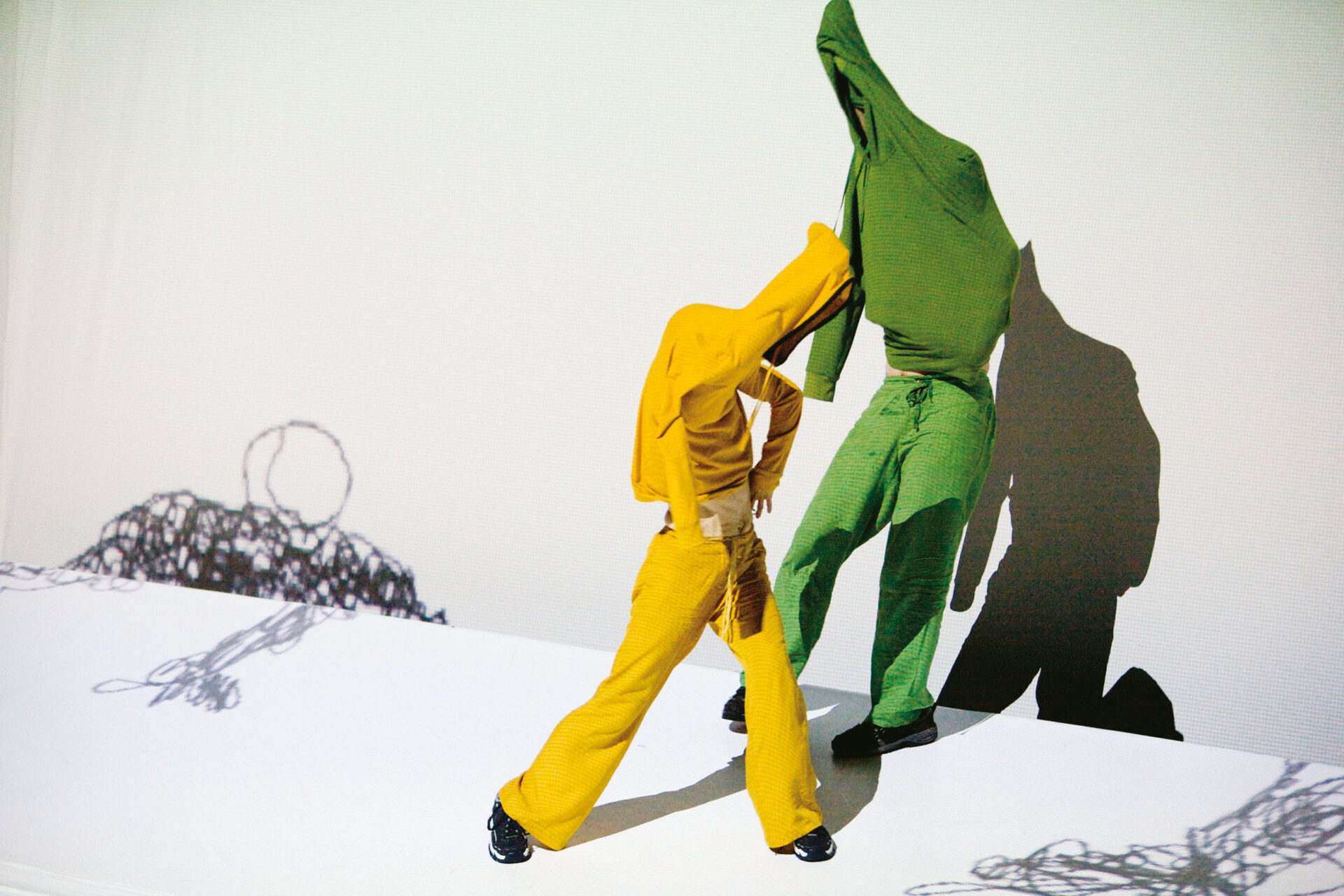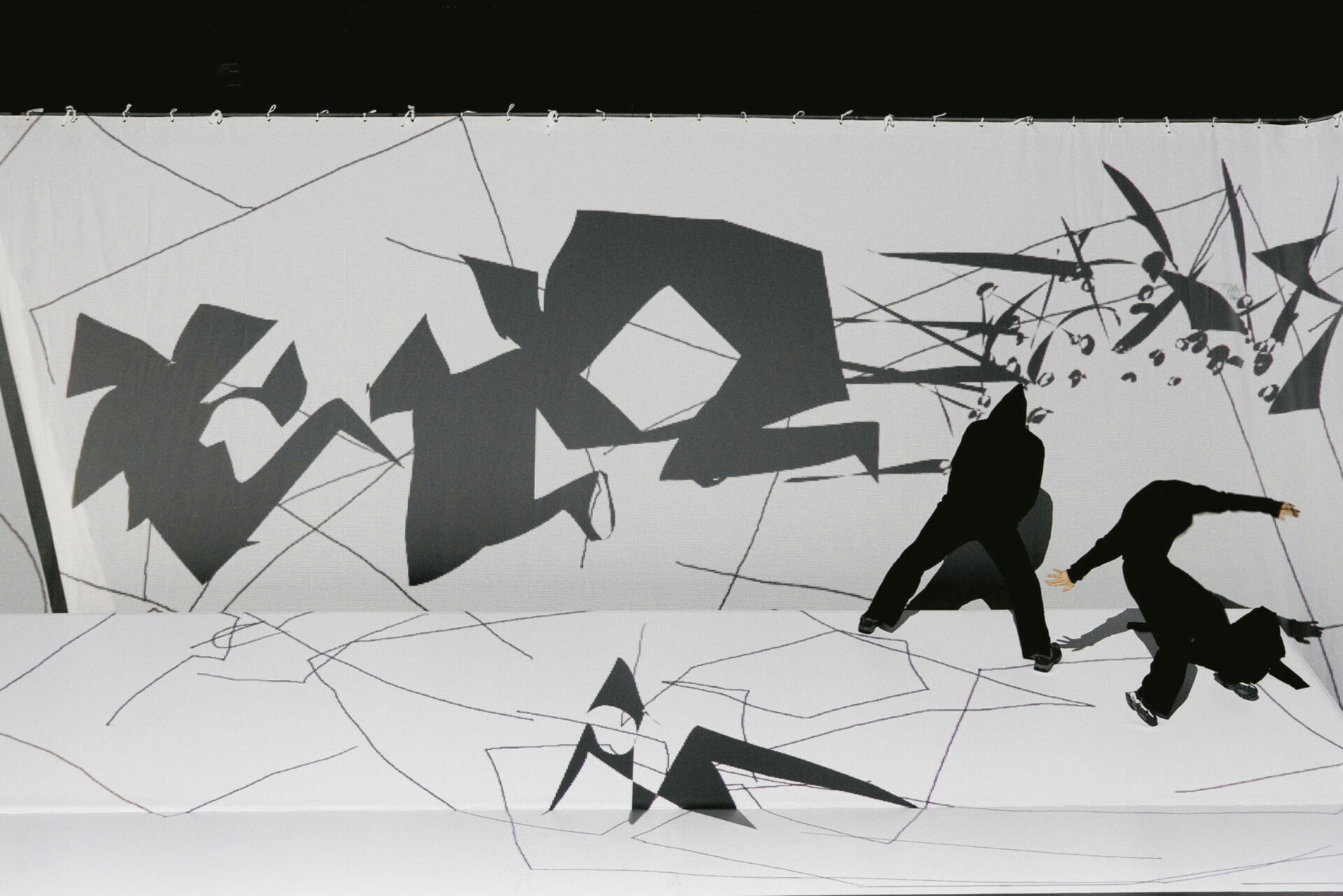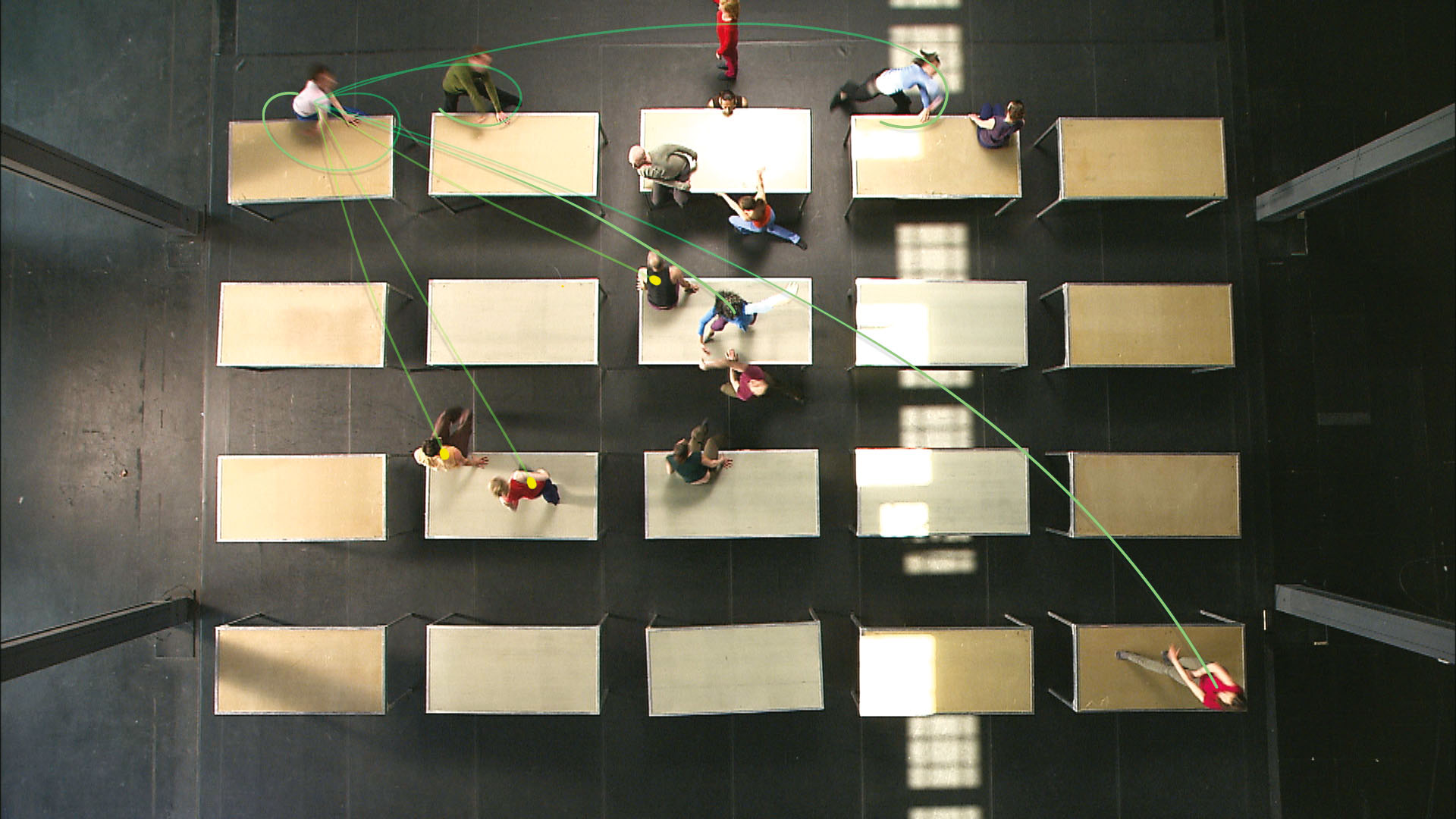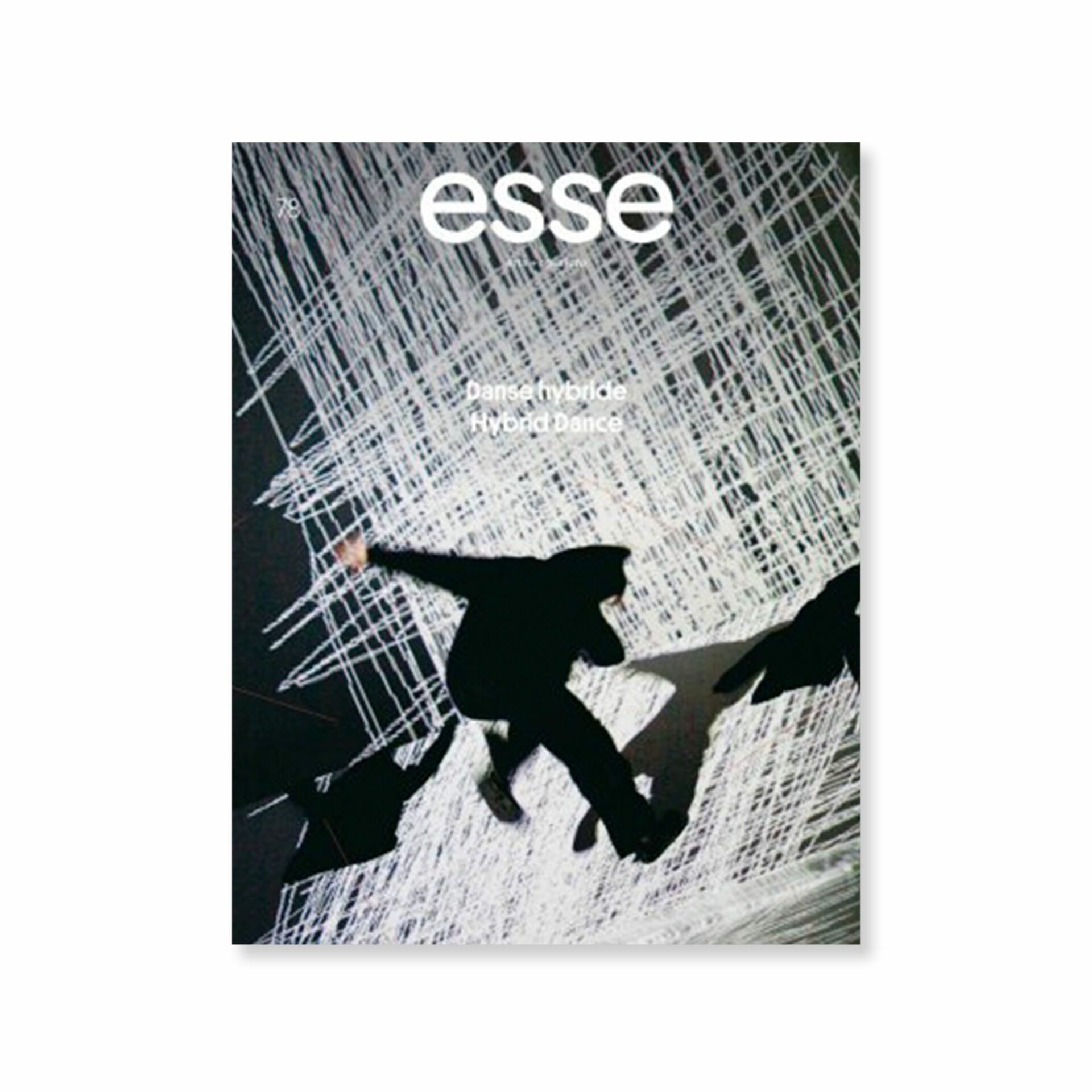
Apparition, 2004.
Photo : permission de | courtesy of Klaus Obermaier & Ars Electronica Futurelab
When thinking of the connections between dance and the visual arts, we tend to forget that dance is directed at the spectator’s eye before being deployed in its intersensorial sensibility, which one may describe in terms of proprioceptive, kinaesthetic, and synaesthetic perceptions. That said, behind the choreographer may well lurk a visual artist (Forsythe, Preljocaj, Saporta, Teshigarawa, Decouflé, Waltz, Lock, among many others who come to mind). Some choreographers, like Jan Fabre, may even be more visual artist than dancer.
Dance, the art of time, space, and body, can mesh with practically any art form. And as the twentieth century shows, it can very well suffice in itself; indeed, it must. Isadora Duncan danced without stage scenery, and at Hellerau, despite Émile Jaques-Dalcroze’s best efforts, Mary Wigman created dance without music. Dance, though, cannot do without light.1 1 - A counter-example: In March 1994, Tangente Danse Actuelle drew up a program comprised of braille characters that was meant for an audience composed of both the seeing and the blind; this was part of a “lab” event whose theme was “the sensory universe and its imaginary trajectories.” Lying at the heart of all scenography are the body and its shadows, dance, and lighting. What Adolphe Appia taught us in the early twentieth century holds true in the twenty-first, all the more so in that lighting technologies have developed to the point of blurring the lines between light projection and video projection, which has become all but commonplace since Édouard Lock’s Exaucé/Salt (1998). In one part of the show, a sequence of projected images moved across the backdrop, like spotlights. Circular in form and sometimes comprising close-up shots of faces, the projection produced a strange and paradoxical effect: what kind of lens were we looking through? The omnipresence of media devices has inured us to a plethora of real-time effects, constantly playing with scale and temporality. Artists adopted the digital tools discovered during the “technology shift” of the 1990s, tools that have since been replaced by new ones of exceptional high-performance, thus opening up dance to new worlds and potential new partners.

Photo : © André Cornellier

With Benoît Lachambre’s Is You Me (2008), the stage becomes an augmented and ephemeral space, the white stage floor a screen for Laurent Goldring’s real-time drawings, improvised according to the movements of Lachambre and his partner, Louise Lecavalier. For his solo show Miroku (2007), Saburo Teshigarawa used projections on three sides and danced in a huge light box. Though not serving to screen iconographic images, this scenographic arrangement suggests CAVE (Cave automatic virtual environment) technology, used at MIT and elsewhere for immersive virtual reality. With digital technology, interdisciplinarity often becomes interactive in real time. The arts can be made to play off each other as musical instruments do in jazz, or pre-programmed computer algorithms can be given the job of instantly arranging multiple elements of a show. In Klaus Obermaier’s Apparition (2004), for example, a system of artificial vision captured a dancer’s form, which allowed for real-time projection onto the dancer, whose screen-body was in constant motion. Meanwhile a second projection covered the backdrop; the contrast between the two was of stunning precision.
The frequent use of video and graphics on stage extends the idea of dematerializing the artwork, a trend in technologically-enhanced art that Frank Popper identified in 1975,2 2 - Frank Popper, Le Déclin de l’objet (Paris: Chêne, 1975), 143. at a time when minimalism in the visual arts first and foremost drew attention to the perception of a work, to the phenomenological dimension of a subject’s experience. Nonetheless, new media art has not made the use of tangible materials on stage obsolete. It may in fact have fostered the development of more inventive approaches, if not a desire for “re-materialization,” possibly expressing a weariness with the imperial dominance of computer-generated images. Performance art and butoh had already helped foreground the body as material rather than as a vector for choreographic codes, an approach that favoured bodily contact with organic matter, water, stone, and fabric, to name but a few. It’s a matter of accentuating the sensuality of dance or even making it outright dangerous, as in Vandekeybus’ What the Body Does Not Remember (1987), in which the dancer throws a brick in the air.
Matter and materials are not employed to produce only images but to fully solicit the dancing body. Like the body, but unlike projected images, physical objects have weight, are subject to gravity, and offer a degree of resistance to contact and effort. Because of their structural and physical qualities — elasticity, centre of gravity, density, consistency — which cause them to act in particular ways, they find psychological and somatic resonance in us. As for “dematerializing” technological devices, they are more reliable and precise in terms of performance than we can ever hope to be; by that very fact, they cannot touch us as raw matter does, subject as it is to the same laws as us, affecting us everywhere and all the time. With or without new technologies, it isn’t a matter of using decor to create images but of providing tangible elements for interaction, both symbolic and mechanical. Thus, in William Forsythe’s One Flat Thing Reproduced (2000), tables become trestles and apparatus, and the physical and kinetic qualities of the object influences — even enables — the dancer’s performance. While the dancer and the object with which he or she physically engages may be analyzed according to the four factors of Rudolf von Laban’s movement theory — time, space, flux, weight — projected images are limited to time and space; their flux is set and, weightless, they offer no resistance to effort and remain foreign to the real.


Photos : permission de | courtesy of The Ohio State University & the Forsythe Company

Some technophile artists push interactivity to the extent of simulation, creating stage environments where dancers seem to be able to touch projected three-dimensional forms, lending them qualities they do not possess.3 3 - Kim Vincs and John McCormick, “Touching Space: Using Motion Capture and Stereo Projection to Create a ‘Virtual Haptics’ of Dance,” Leonardo, Vol. 43, No. 4 (2010): 359-366. This human-machine interaction is as much of interest to dance as to theatre for generating hybrid spaces. The technological challenges of simulating material qualities and real-time interactions have a definite impact on the aesthetics of representation: they change not only the scenography but the dance itself. Real physical interactions with tangible material remain more convincing today than technologically virtualized ones. Be that as it may, dramatic art, choreography, and scenography are inextricable. To the extent that ground contact is all but inevitable in dance,4 4 - Methods of suspension are sometimes used, however, as in Man Walking Down the Side of a Building (Trisha Brown, 1970), The Rapture Series (Noémie Lafrance, 2008-2018), Immer das Selbe Gelogen (Vandekeybus, 1991), and Amu (Wayne McGregor, 2005). one may conjure physical interactions in which various types of ground-cover are employed: carpeting, turf, sand, even broken glass (Teshigarawa, Glass Tooth, 2006) — indeed, anything we can dream up. Besides, one cannot conceive Kurt Jooss’ The Green Table (1932) without a large conference table; nor Im Bade wannen (Suzanne Linke, 1980) without a bathtub; nor Bras de plomb (Paul-André Fortier, 1993) without Betty Goodwin’s “props.” Collaborations between choreographers and visual artists are innumerable, whether it be “non-dance” or contemporary ballet. In “non-dance,” the body is one element among many others in blown-up, undisciplined, and “non-disciplinary” compositions where anything can serve as costume, mask, accessory, or decor, changing uses along the way. Hierarchies fall, things get mixed up, identities merge, through subversions, perversions, diversions. It is difficult — sometimes impossible — to isolate the dance from the artistic proposal as a whole; everything proceeds from a logic that, nonetheless, does not aspire to totality. Dance may thus forgo the stage and its theatrical conventions, reject illusionism and the black box, refuse the dictates of the “prince’s eye,” that is, the laws of perspective.
With his company Par B.L.eux, Benoît Lachambre (“B.L.”) multiplies his collaborations with dancers, performers, visual artists, and musicians (“eux,” or them), and, with Confort et complaisance (2000), proposes a work that may still be considered emblematic of “non dance.” Spectators must first perambulate through Julie Andrée T.’s dance installation, which looks like an exhibition of biological art, and experience some confusion and disorientation before understanding where the stage and seats are (John Cage prepared pianos, one can also prepare audiences). Naked bodies, suspended or slumped, plastic objects, fur, the proximity of the dancers, bowls, inflatable sofas made of transparent PVC on which a dancer does the splits: everything is seen as it is; spectators too, since they face each other on two opposing tiers. The performers’ exhibitionism is matched by the exhibition of spectators. It is all about dance, but everything is first of a visual nature, the audience included (irrespective of the audio dimension).
In a sense, Lachambre had set the tone one year earlier with Délire défait (1999), a kind of choreographed multimedia autobiography in which he took charge of concept, choreography, and dance. Geometric motifs on the floor of red, yellow, and blue lines suggested a gym; a playground for games whose rules were yet to be invented, as evinced when Lachambre pulled the gaffer tape from the marley floor and rolled it around his head, taking us from a Mondrian-like visual aesthetic to a McCarthyesque performance. Capturing spectators on video was just as ingenious, as it paradoxically brought spectators and performers closer together. None of the discomfort here that Confort et complaisance might have created for some audience members with its unapologetic crudeness. With Lachambre, scenography is sometimes more striking than the choreography, the quality of the dance essentially resting on that of the dancers’ presence.
Media technologies and devices answer to a constant desire — if not an obligation — to take dance further, take it elsewhere, even if it means leaving behind the experiential body — be it in dance films, video-dance, virtual dance, or dance installations such as Steve Paxton’s Phantom Exhibition (2009). Surrounded by images projected onto the four walls and ceiling of the immersive installation, visitors are presumed to be capable of seeing the relationship between gravity and the human body, between the interior and the exterior of the body and its bone structure. Data from motion tracking and capture can be used to create new art forms through visualization. A prime example is Synchronous Objects for One Flat Thing, Reproduced (2009), by William Forsythe and Ohio State University, which led to virtual sculptural forms (hence the addition of “Synchronous Objects for” to the title of the work initially meant for the stage). These abstract forms are generated through motion tracking5 5 - Motion tracking consists of literally tracking the movements of the dancer, or of any object for that matter. Motion capture, on the other hand, is concerned not only with the body’s motion but its motility as well, that is, with movements of the head, limbs, torso. The capture can vary in its precision, depending on the markers placed on the bodies and the technologies used (mechanical, optical, magnetic, etc.). together with ways of visualizing the data. Twenty-odd of these “synchronous objects” may be viewed on the project’s website in the form of fixed, moving, or interactive images.6[REFcount=6]http://synchronousobjects.osu.edu/content.html#[/REF]
One can distinguish two trends in collaborations between dance and the visual arts: one tends toward purification, with a predilection for digital technology, and the other toward a most heterogeneous mix. This polarity does not necessarily function along the same axis as other conceptualizations by which we understand a work, be they aesthetic (illusionist/critical; abstraction/theatricalization), philosophical (real/virtual; autonomy/heteronomy of the arts), or stylistic (design/trash; minimalist/kitsch). While “Cunninghamesque” collaborations were based on the autonomy of artistic disciplines and culminated in their interconnection, in the mind of the present avant-garde, collaborations such as “non-dance,” far from favouring autonomy, repudiate it. But what is understood as “dance” is ephemeral and cannot be easily separated from theatre, performance, or mime.7 6 - The Ubuesque Mori el Merma (1978), the outcome of an encounter between Joan Mirò and La Claca theatre, has affinities with Paul McCarthy’s video Painting, Wall Whip (1974). The former is variously described as puppet show, carnival of masks, mime, or ballet, while the latter the author himself calls “painting as action.” As for Ribot, Lacey, Stuart, Waltz, Lachambre, and Platel, they hardly care that others do not consider their art as “dance.” With the digital shift in the arts, a new avenue is emerging where disciplines preserve their autonomy yet offer their digital doubles as data that can be combined with others to arrive at such original forms as “Synchronous Objects.”
[Translated from the French by Ron Ross]
